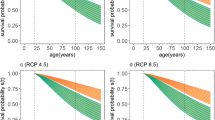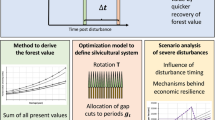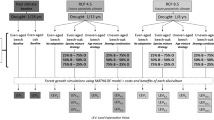Abstract
The ecological consequences of climate change on forest ecosystems have been intensively studied in forest science. In contrast, studies on the economic performance of important tree species that investigate the financial impact of growing those species as monocultures or mixed stands are scarce. We use climate-sensitive survival probabilities to account for natural risk of tree mortality, as well as risk of fluctuating timber prices, to assess the financial performance of spruce and beech stands, pure and mixed, in the context of portfolio theory. We also compare the influence of changing climate to the impact of silvicultural options that forest owners can use to influence financial consequences: pruning spruce and avoiding planting by allowing beech to regenerate naturally. Results show that stands of pure spruce are affected by climate change through reduced mean annuities and increased standard deviation of these annuities. Admixing beech into the stands lowers this shift; by analyzing the displacement vector, we found that 7% share of beech halves the shift and a share of 49% beech reduces the length of the trajectory to 20–25%. However, the changes in risk detected for stands of spruce are relatively low compared to the influence of the silvicultural actions pruning or planting. A sensitivity scenario assuming reduced timber yields for spruce, due to climate change, and slightly increased timber yields for beech resulted massive losses in economic return in stands containing spruce. However, the economic return of spruce-dominated stands was still much higher than that of beech-dominated stands. A small admixture of beech in a spruce-dominated stand led to a comparable economic return compared to a spruce monoculture under all scenarios, with a lower level of risk.


Similar content being viewed by others
References
Abson DJ, Fraser EDG, Benton TG (2013) Landscape diversity and the resilience of agricultural returns: a portfolio analysis of land-use patterns and economic returns from lowland agriculture. Agric Food Secur 2(2):1–15
Albert M, Hansen J, Nagel J, Schmidt M, Spellmann H (2015) Assessing risks and uncertainties in forest dynamics under different management scenarios and climate change. For Ecosyst 2(1):7063
Ayres MP, Lombardero MJ (2000) Assessing the consequences of global change for forest disturbance from herbivores and pathogens. Sci Total Environ 262(3):263–286
Beinhofer B (2010a) Comparing the financial performance of traditionally managed beech and oak stands with roomy established and pruned stands. Eur J For Res 129(2):175–187
Beinhofer B (2010b) Producing softwood of different quality: does this provide risk compensation? Eur J For Res 129(5):921–934
Bolte A, Czajkowski T, Kompa T (2007) The north-eastern distribution range of European beech a review. Forestry 80(4):413–429
Bolte A, Ammer C, Löf M, Madsen P, Nabuurs G, Schall P, Spathelf P, Rock J (2009) Adaptive forest management in central Europe: climate change impacts, strategies and integrative concept. Scand J For Res 24(6):473–482
Castro LM, Calvas B, Knoke T (2015) Ecuadorian banana farms should consider organic banana with low price risks in their land-use portfolios. PLoS ONE 10(3):e0120384
Clark JD, Bell DM, Hersh MH, Nichols L (2011) Climate change vulnerability of forest biodiversity: climate and competition tracking of demographic rates. Glob Chang Biol 17(5):1834–1849
Dieter M, Moog M, Borchert H (2001) Considering serious hazards in forest management decision-making. In: Gadow K von (ed) Risk analysis in forest management, vol 2. Managing Forest Ecosystems. Springer, Netherlands, pp 201–232
Djanibekov U, Khamzina A (2016) Stochastic economic assessment of afforestation on marginal land in irrigated farming system: environmental and resource economics. Environ Resour Econ 63(1):95–117
Edwards SF, Link JS, Rountree BP (2004) Portfolio management of wild fish stocks. Ecol Econ 49(3):317–329
Edwards DM, Jay M, Jensen FS, Lucas B, Marzano M, Montagné C, Peace A, Weiss G (2012) Public preferences across Europe for different forest stand types as sites for recreation. Ecol Soc 17(1)
Falk W, Hempelmann N (2013) Species favourability shift in Europe due to climate change: a case study for Fagus sylvatica L. and Picea abies (L.) Karst. based on an ensemble of climate models. J Climatol 2013(6):1–18
Figge F (2004) Bio-folio: applying portfolio theory to biodiversity. Biodivers Conserv 13(4):827–849
Gamfeldt L, Snäll T, Bagchi R, Jonsson M, Gustafsson L, Kjellander P, Ruiz-Jaen MC, Fröberg M, Stendahl J, Philipson CD, Mikusiński G, Andersson E, Westerlund B, Andrén H, Moberg F, Moen J, Bengtsson J (2013) Higher levels of multiple ecosystem services are found in forests with more tree species. Nat Commun 2013(4):1340
Griess VC, Knoke T (2011) Growth performance, wind-throw, and insects: meta-analyses of parameters influencing performance of mixed-species stands in boreal and northern temperate biomes. Can J For Res 41:1141–1158
Griess VC, Knoke T (2013) Bioeconomic modeling of mixed Norway spruce—European beech stands: economic consequences of considering ecological effects. Eur J For Res 132(3):511–522
Griess VC, Acevedo R, Härtl F, Staupendahl K, Knoke T (2012) Does mixing tree species enhance stand resistance against natural hazards? A case study for spruce. For Ecol Manag 267:284–296
Hahn WA, Knoke T (2010) Sustainable development and sustainable forestry: analogies, differences, and the role of flexibility. Eur J For Res 129(5):787–801
Hanewinkel M, Cullmann DA, Schelhaas M, Nabuurs G, Zimmermann NE (2013) Climate change may cause severe loss in the economic value of European forest land. Nat Clim Chang 3(3):203–207
Heikkinen V (2002) Co-integration of timber and financial markets—implications for portfolio selection. For Sci 48(1):118–128
Hijmans RJ, Cameron SE, Parra JL, Jones PG, Jarvis A (2005) Very high resolution interpolated climate surfaces for global land areas. Int J Climatol 25(15):1965–1978
Hildebrandt P, Knoke T (2011) Investment decisions under uncertainty—a methodological review on forest science studies. Forest Policy Econ 13(1):1–15
Hyytiäinen K, Penttinen M (2008) Applying portfolio optimisation to the harvesting decisions of non-industrial private forest owners. Forest Policy Econ 10(3):151–160
IPCC (2000) Emissions scenarios: summary for policymakers, Cambridge, United Kingdom
Jacobsen JB, Thorsen BJ (2003) A Danish example of optimal thinning strategies in mixed-species forest under changing growth conditions caused by climate change. For Ecol Manag 180(1–3):375–388
Kindermann GE, Schörghuber S, Linkosalo T, Sanchez A, Rammer W, Seidl R, Lexer MJ (2013) Potential stocks and increments of woody biomass in the European Union under different management and climate scenarios. Carbon Balance Manag 8:2
Knoke T, Seifert T (2008) Integrating selected ecological effects of mixed European beech–Norway spruce stands in bioeconomic modelling. Ecol Model 210(4):487–498
Knoke T, Weber M (2006) Expanding carbon stocks in existing forests—a methodological approach for cost appraisal at the enterprise level. Mitig Adapt Strateg Glob Chang 11(3):579–605
Knoke T, Wurm J (2006) Mixed forests and a flexible harvest policy: a problem for conventional risk analysis? Eur J For Res 125(3):303–315
Knoke T, Stimm B, Ammer C, Martin M (2005) Mixed forests reconsidered: a forest economics contribution to the discussion on natural diversity. For Ecol Manag 213:102–116
Knoke T, Ammer C, Stimm B, Mosandl R (2008) Admixing broadleaved to coniferous tree species: a review on yield, ecological stability and economics. Eur J For Res 127(2):89–101
Knoke T, Paul C, Hildebrandt P, Calvas B, Castro LM, Härtl F, Döllerer M, Hamer U, Windhorst D, Wiersma YF, Curatola Fernandez GF, Obermeier WA, Adams J, Breuer L, Mosandl R, Beck E, Weber M, Stimm B, Haber W, Fürst C, Bendix J (2016) Compositional diversity of rehabilitated tropical lands supports multiple ecosystem services and buffers uncertainties. Nat Commun 7: Article number: 1187. doi:10.1038/ncomms11877
Lausti A, Penttinen M (1998) The analysis of return and its components of non-industrial private forest ownership by forestry board districts in Finland. Silva Fenn 32(1)
Lien G, Hardaker JB (2001) Whole-farm planning under uncertainty: impacts of subsidy schome and utility function on portfolio choice in Norwegian agriculture. Eur Rev Agric Econ 28(1):17–36
Lindner M, Maroschek M, Netherer S, Kremer A, Barbati A, Garcia-Gonzalo J, Seidl R, Delzon S, Corona P, Kolström M, Lexer MJ, Marchetti M (2010) Climate change impacts, adaptive capacity, and vulnerability of European forest ecosystems. For Ecol Manag 259(4):698–709
Lindner M, Fitzgerald JB, Zimmermann NE, Reyer C, Delzon S, van der Maaten E, Schelhaas M, Lasch P, Eggers J, van der Maaten-Theunissen M, Suckow F, Psomas A, Poulter B, Hanewinkel M (2014) Climate change and European forests: what do we know, what are the uncertainties, and what are the implications for forest management? J Environ Manag 146:69–83
Lönnstedt L, Svensson J (2000) Return and risk in timberland and other investment alternatives of NIPF owners. Scand J For Res 15(6):661–669
Macmillan WD (1992) Risk and agricultural land use: a reformulation of the portfoliotheoretic approach to the analysis of a von Thünen Economy. Geogr Anal 24(2):142–158
Markowitz H (1952) Portfolio Selection. J Fiance 7(1):77–91
Markowitz HM (2010) Portfolio theory: as i still see it. Annu Rev Financ Econ 2(1):1–23
Metz J, Annighöfer P, Schall P, Zimmermann J, Kahl T, Schulze ED, Ammer C (2016) Site adapted admixed tree species reduce drought susceptibility of mature European beech. Glob Chang Biol 22:903–920
Mills WL Jr, Hoover WL (1982) Investment in forest land: aspects of risk and diversification. Land Econ 58(1):33–51
MPIMET (2003) The atmospheric general circulation model ECHAM5, 349, Hamburg
Neuner S, Beinhofer B, Knoke T (2013) The optimal tree species composition for a private forest enterprise—applying the theory of portfolio selection. Scand J For Res 28(1):38–48
Neuner S, Albrecht A, Cullmann D, Engels F, Griess VC, Hahn WA, Hanewinkel M, Härtl F, Kölling C, Staupendahl K, Knoke T (2015) Survival of Norway spruce remains higher in mixed stands under a dryer and warmer climate. Glob Chang Biol 21(2):935–946
Nothdurft A (2013) Spatio-temporal prediction of tree mortality based on long-term sample plots, climate change scenarios and parametric frailty modeling. For Ecol Manag 291:43–54
Pretsch H, Ďurský J (2002) Growth reaction of Norway spruce (Picea abies (L.) Karst) and European beech (Fagus silvatica L.) to possible climatic changes in Germany. A sensitivity study. Forstwissenschaftliches Centralblatt 121:145–154
Pretzsch H, Biber P, Durský J (2002) The single tree-based stand simulator SILVA: construction, application and evaluation. For Ecol Manag 162:3–21
Pretzsch H, Dieler J, Seifert T, Rötzer T (2012) Climate effects on productivity and resource-use efficiency of Norway spruce (Picea abies [L.] Karst.) and European beech (Fagus sylvatica [L.]) in stands with different spatial mixing patterns. Trees 26(4):1343–1360
Ramìrez OA, Somarriba E, Ludewigs T, Ferreira P (2001) Financial returns, stability and risk of cacao-plantain-timber agroforestry systems in Central America. Agrofor Syst 51(2):141–154
Ravindranath NH (2007) Mitigation and adaptation synergy in forest sector. Mitig Adapt Strateg Glob Chang 12(5):843–853
Rötzer T, Liao Y, Goergen K, Schüler G, Pretzsch H (2013) Modelling the impact of climate change on the productivity and water-use efficiency of a central European beech forest. Clim Res 58(1):81–95
Sethi SA, Dalton M (2012) Risk measures for natural resource management: description, simulation testing, and R Code with fisheries examples. J Fish Wildl Manag 3(1):150–157
Thomson T (1997) Long-term portfolio returns from timber and financial assets. J Real Estate Portf Manag 3(1):57–73
van Asseldonk M, Langeveld J (2007) Coping with climate change in agriculture: a portfolio analysis: paper prepared for presentation at the 101st EAAE Seminar ‘Management of Climate Risks in Agriculture’, Berlin
Wagner JE, Rideout DB (1991) Evaluating forest management investments: the capital asset pricing model and the income growth model. For Sci 37(6):1591–1604
Acknowledgements
This study is part of the project “Uncertainty and the bioeconomics of near-natural silviculture,” KN 586/7-2, funded by the German Research Foundation (DFG).
Author information
Authors and Affiliations
Corresponding author
Rights and permissions
About this article
Cite this article
Neuner, S., Knoke, T. Economic consequences of altered survival of mixed or pure Norway spruce under a dryer and warmer climate. Climatic Change 140, 519–531 (2017). https://doi.org/10.1007/s10584-016-1891-y
Received:
Accepted:
Published:
Issue Date:
DOI: https://doi.org/10.1007/s10584-016-1891-y




